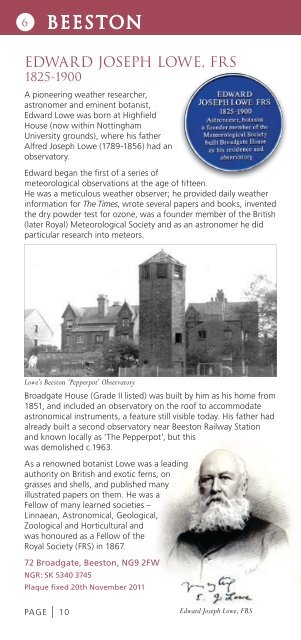GUIDE TO THE BLUE PLAQUES
BP%20final%20proof.2016.05.03
BP%20final%20proof.2016.05.03
Create successful ePaper yourself
Turn your PDF publications into a flip-book with our unique Google optimized e-Paper software.
BEES<strong>TO</strong>N<br />
BEES<strong>TO</strong>N<br />
6 7<br />
EDWARD JOSEPH LOWE, FRS<br />
1825-1900<br />
A pioneering weather researcher,<br />
astronomer and eminent botanist,<br />
Edward Lowe was born at Highfield<br />
House (now within Nottingham<br />
University grounds), where his father<br />
Alfred Joseph Lowe (1789-1856) had an<br />
observatory.<br />
Edward began the first of a series of<br />
meteorological observations at the age of fifteen.<br />
He was a meticulous weather observer; he provided daily weather<br />
information for The Times, wrote several papers and books, invented<br />
the dry powder test for ozone, was a founder member of the British<br />
(later Royal) Meteorological Society and as an astronomer he did<br />
particular research into meteors.<br />
THOMAS HUMBER<br />
1841-1910<br />
Thomas Humber is the man who brought<br />
industrial-scale cycle manufacturing to<br />
Beeston. A talented engineer, he worked<br />
in various small Nottingham businesses,<br />
until, inspired by a French velocipede,<br />
he set up to copy, improve and then<br />
manufacture cycles in his home workshop.<br />
Lowe’s Beeston ‘Pepperpot’ Observatory<br />
Broadgate House (Grade II listed) was built by him as his home from<br />
1851, and included an observatory on the roof to accommodate<br />
astronomical instruments, a feature still visible today. His father had<br />
already built a second observatory near Beeston Railway Station<br />
and known locally as ‘The Pepperpot’, but this<br />
was demolished c.1963.<br />
As a renowned botanist Lowe was a leading<br />
authority on British and exotic ferns, on<br />
grasses and shells, and published many<br />
illustrated papers on them. He was a<br />
Fellow of many learned societies –<br />
Linnaean, Astronomical, Geological,<br />
Zoological and Horticultural and<br />
was honoured as a Fellow of the<br />
Royal Society (FRS) in 1867.<br />
72 Broadgate, Beeston, NG9 2FW<br />
NGR: SK 5340 3745<br />
Plaque fixed 20th November 2011<br />
PAGE | 10<br />
Edward Joseph Lowe, FRS<br />
Humber Cycle Works, c.1904, courtesy of Mr W Spencer and www.picturethepast.org.uk<br />
Progressing to bigger premises, he moved his home and business to<br />
Beeston in 1878. He worked through two successive partnerships,<br />
formed a limited company in 1887, then built larger premises on New<br />
Lane – later renamed Humber Road – where the distinctive Humber<br />
‘Wheel of Life’ symbols can still be seen on the surviving building.<br />
Initially employing about eighty men, he continued to improve cycle<br />
design and workmanship quality. The company<br />
grew rapidly as sales and premises expanded<br />
and, although Thomas retired from active<br />
participation in 1892, by 1898 there were<br />
some 2,000 employees, making the<br />
company Beeston’s largest employer and<br />
one of the country’s major cycle firms.<br />
The description ‘Beeston Humber’ became<br />
synonymous worldwide with quality and<br />
reliability, putting Beeston on the world cycle<br />
map. In the 1890s and beyond, bicycles and<br />
tricycles were favoured by royalty, some adverts<br />
proclaiming ‘Humber, the Royal Cycle’.<br />
Manufacture of motorcycles began in 1896,<br />
followed shortly afterwards by motorcars.<br />
However, a decision was later made to move all manufacture to<br />
Coventry. The Beeston works closed in 1908, leaving hundreds of<br />
empty houses as families sought work elsewhere.<br />
The Dojo, Humber Road, Beeston, NG9 2ET<br />
NGR: SK 5356 3695<br />
Plaque unveiled 21st August 2011<br />
HM King Edward VII on<br />
his Humber Tricycle<br />
PAGE | 11


